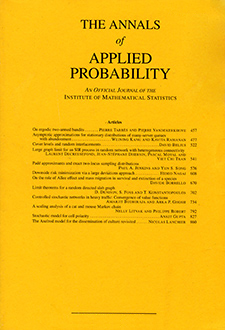Abstract
Functionals $L$ on finite subsets $A$ of $\mathbb{R}^d$ are considered for which the value is the minimum total edge length among a class of graphs with vertex set equal to, or in some cases containing, $A$. Examples include minimal spanning trees, the traveling salesman problem, minimal matching and Steiner trees. Beardwood, Halton and Hammersley, and later Steele, have shown essentially that for $\{X_1, \ldots, X_n\}$ a uniform i.i.d. sample from $\lbrack 0,1 \rbrack^d, EL(\{X_1, \ldots, X_n\})/n^{(d-1)/d}$ converges to a finite constant. Here we bound the rate of this convergence, proving a conjecture of Beardwood, Halton and Hammersley.
Citation
Kenneth S. Alexander. "Rates of Convergence of Means for Distance-Minimizing Subadditive Euclidean Functionals." Ann. Appl. Probab. 4 (3) 902 - 922, August, 1994. https://doi.org/10.1214/aoap/1177004976
Information





